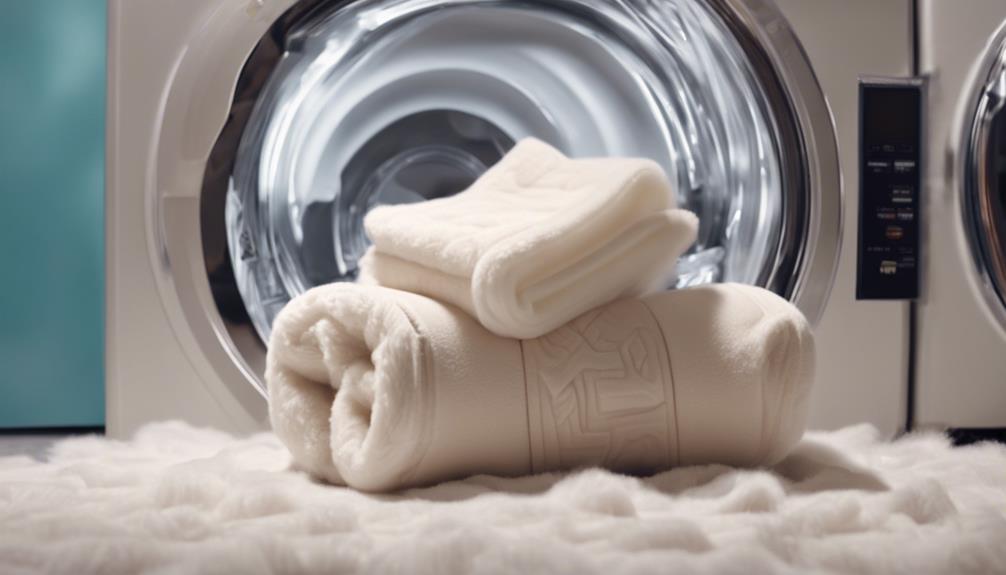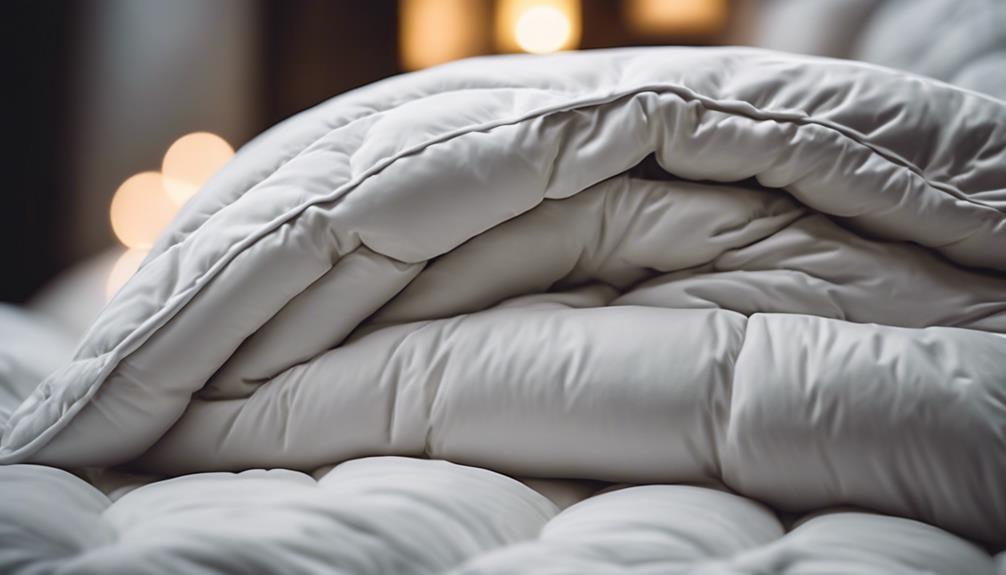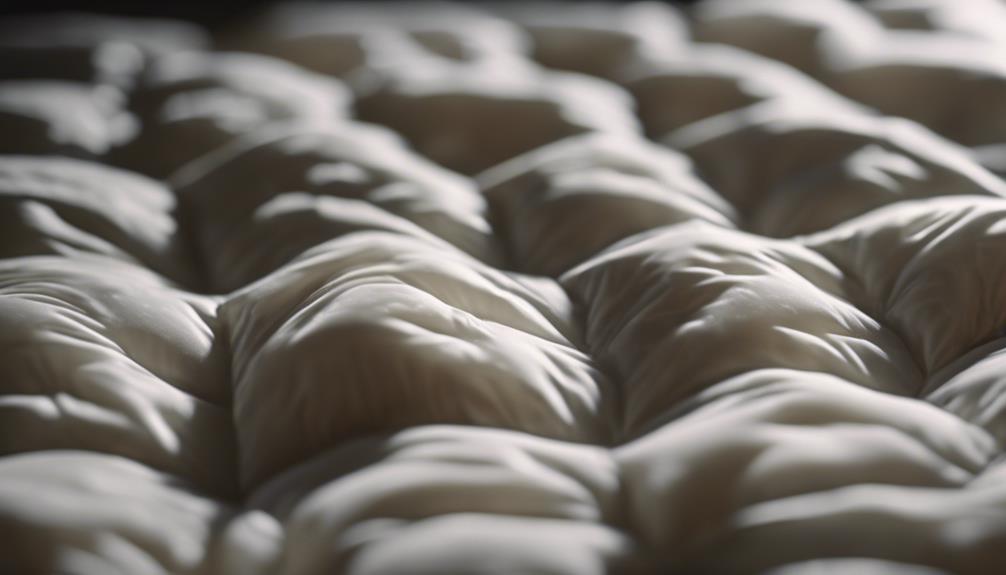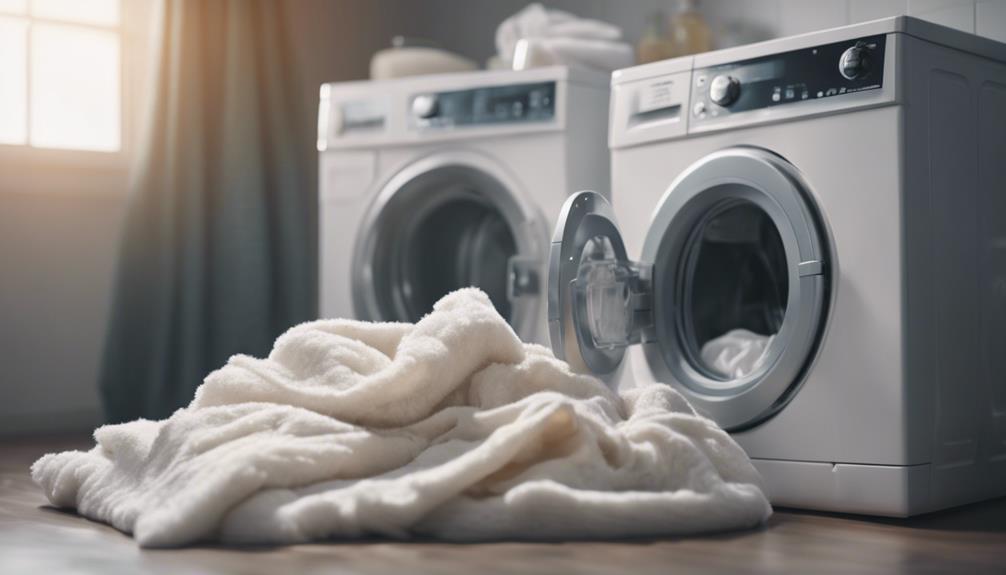Yes, you are able to machine wash your UGG comforter. Refer to the care label for machine wash instructions, select a gentle cycle with cold water, and wash separately or with similar items. Avoid using harsh chemicals or bleach to preserve its durability and plushness. For a more detailed guide on machine washing your UGG comforter and tips to ensure its longevity and softness, please follow our expert recommendations. Use mild, hypoallergenic detergent and air dry for optimal results. Maintain your UGG comforter’s freshness by adhering to proper washing techniques and stain removal strategies. Be assured that with proper care, your UGG comforter will continue to provide warmth and comfort.
Key Takeaways
- Check care label for machine washability and specific instructions
- Use a front-loading machine with a gentle cycle for washing
- Wash separately or with similar items to prevent damage
- Opt for a mild detergent suitable for delicate fabrics
- Air dry the comforter to maintain quality and fluffiness
Care Instructions for Machine Washing UGG Comforter
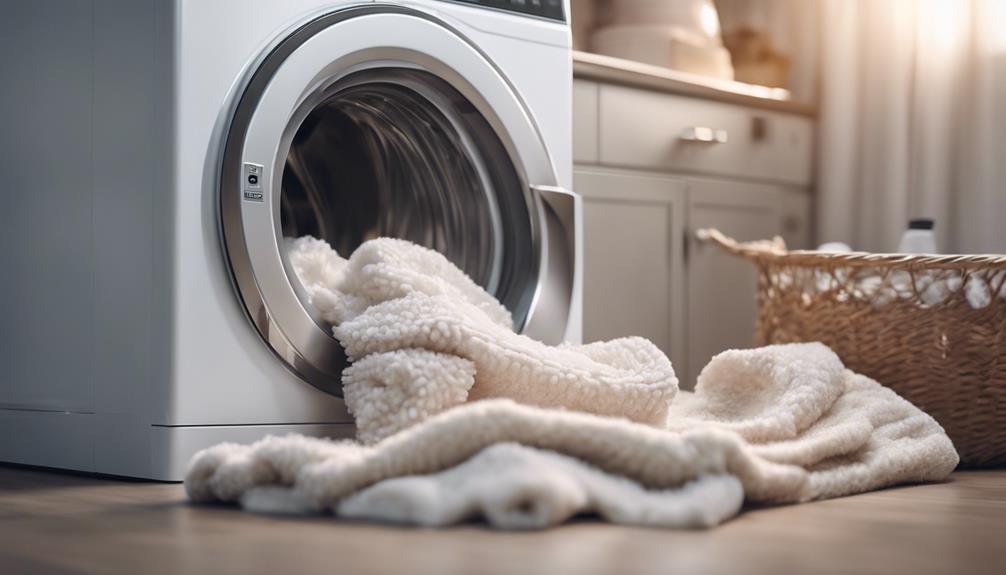
To properly care for your Ugg comforter by machine washing, follow the specific care instructions provided to guarantee the best results. Before tossing your Ugg comforter into the washing machine, make sure to check the care label to confirm it's safe for machine washing.
When it comes to machine washing your Ugg comforter, opt for a gentle cycle and cold water. This will help prevent any damage to the delicate fibers of the comforter. It's also advisable to wash the comforter separately or with similar items to ensure even wear and thorough cleaning.
Additionally, avoid using harsh chemicals or bleach when machine washing your Ugg comforter. These substances can compromise the quality and softness of the fabric. By following these care instructions for machine washing your Ugg comforter, you can maintain its durability and plushness for a longer period.
Choosing the Right Detergent for UGG Comforter
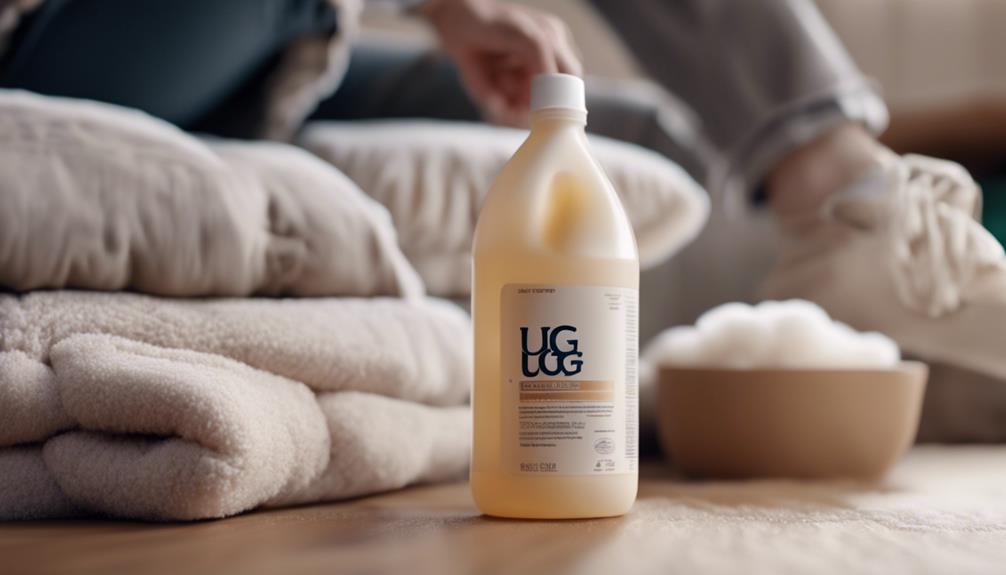
When selecting a detergent for your UGG comforter, it's important to choose a mild option that's gentle on delicate fabrics.
Opt for hypoallergenic and dermatologist-tested detergents to guarantee compatibility with your UGG comforter and prevent skin irritation.
Consider eco-friendly options with plant-based ingredients for a more sustainable washing process.
Proper Detergent Selection
When washing your UGG comforter, opt for a mild detergent to protect the delicate fibers and maintain quality. Selecting a hypoallergenic and dermatologist-tested detergent guarantees gentleness on the comforter, while choosing a plant-based option offers an eco-friendly alternative.
If you enjoy a subtle scent, go for a lightly fragranced detergent to add a pleasant aroma to your freshly washed UGG comforter. It's important to avoid harsh chemicals in detergents to preserve the fluffiness and overall quality of your UGG comforter.
Compatibility With UGG
For the optimal outcome in washing your UGG comforter, choose a mild detergent that's gentle on the delicate fibers. Opting for a hypoallergenic detergent, which is dermatologist-tested, will help maintain the quality of your comforter.
Consider using a plant-based detergent to reduce environmental impact while keeping your UGG comforter clean. If you enjoy a light fragrance on your bedding, select a lightly scented detergent.
Harsh chemicals should be avoided as they can compromise the fluffiness and softness of your UGG comforter. By selecting the right detergent, you can be confident that your UGG comforter remains cozy and in top condition after each wash.
Machine Washing Steps for UGG Comforter
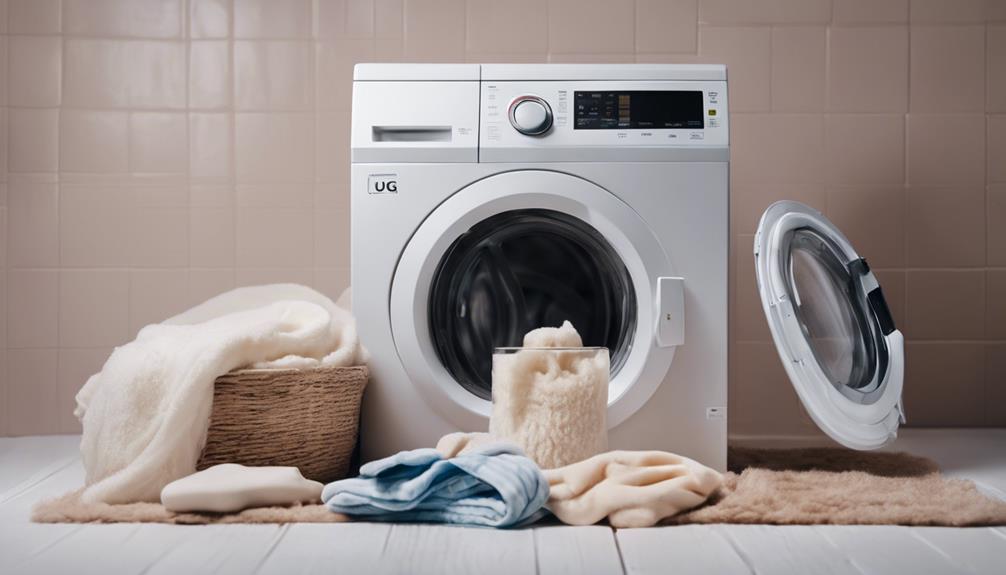
To properly machine wash your UGG comforter, make sure that you check the care label for machine washability and select a front-loading washing machine with a gentle cycle. Before starting the washing process, make certain that your comforter isn't too large for the machine to allow proper cleaning. If it is, consider using a laundromat with a larger capacity machine. When loading the comforter into the machine, wash it separately or with items of similar fabric and color to avoid any potential damage during the wash cycle.
Next, add a mild detergent specifically designed for delicate fabrics. Avoid using hot water, as it can cause shrinkage or damage to the filling of the comforter. Opt for a gentle cycle to ensure a thorough yet safe cleaning process. Once the wash cycle is complete, remove the UGG comforter promptly and hang it to air dry. This method helps maintain the quality and fluffiness of your comforter. Remember to avoid harsh detergents that could potentially harm the fabric.
Avoiding Common Mistakes in UGG Comforter Washing

When washing your UGG comforter, it's important to adhere to the care label instructions and avoid using hot water or harsh detergents to prevent damage. Proper washing techniques, selecting the right detergent, and opting for suitable drying methods are essential to maintain the quality of your comforter.
Overloading the washing machine or choosing the wrong settings can lead to fiber damage or shrinking, so it's important to follow these guidelines for successful UGG comforter washing.
Proper Washing Techniques
What're the key steps to guarantee successful machine washing of your UGG comforter while avoiding common mistakes?
When machine washing your UGG comforter, it's important to use a front-loading washing machine on a gentle cycle to prevent damage.
Always follow the care label instructions provided by the manufacturer to maintain the quality of the comforter.
To make sure of even wear, wash the comforter and shams together in a separate load.
Prior to washing, pre-treat any stains promptly to enhance the likelihood of effective stain removal.
For added protection, consider using a mesh laundry bag for the shams to prevent tangling or damage during the wash cycle.
Choosing the Right Detergent
We always choose a mild detergent when washing our UGG comforter to guarantee the fabric remains undamaged and retains its softness and fluffiness. Selecting an essential detergent is important to avoid harsh chemicals that can strip the comforter's delicate fibers.
Opt for hypoallergenic and dermatologist-tested detergents to prevent any potential skin irritation, especially if you have sensitive skin. Consider using plant-based detergents for a more eco-friendly and gentle wash that maintains the quality of your UGG comforter.
If you enjoy a subtle scent, choose a lightly fragranced detergent to add a pleasant aroma to your freshly washed comforter without overwhelming the fabric. Make sure to follow the detergent manufacturer's instructions for the best results.
Drying Methods for UGG
To maintain the quality and fluffiness of your UGG comforter, opt for air drying instead of using a machine dryer. When air drying, consider hanging your comforter in a well-ventilated area.
Sunlight can be beneficial as it helps sanitize and freshen the comforter during the drying process. However, be cautious of prolonged exposure to direct sunlight to prevent sun bleaching and potential color fading.
It's crucial to monitor the drying time to make certain the comforter isn't left out for too long. Additionally, make sure the surface where you hang your comforter is clean to avoid dirt or debris transferring back onto it.
Following these steps can help sustain the quality of your UGG comforter for longer.
Drying Tips for UGG Comforter
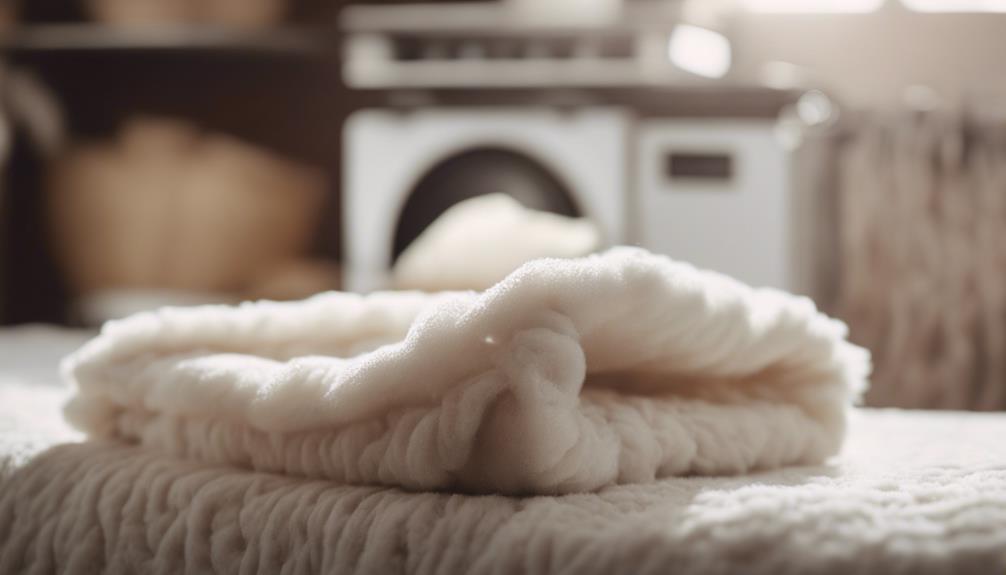
Hanging the UGG comforter to air dry preserves its quality and enhances sanitation. It's important to avoid machine drying to prevent any potential damage to the fibers. By allowing the comforter to air dry naturally, you not only maintain its quality but also help freshen it up. Here are some tips to guarantee effective drying:
| Drying Tips for UGG Comforter |
|---|
| Hang your comforter in a well-ventilated area |
| Avoid direct sunlight to prevent sun bleaching |
| Make sure the comforter is completely dry before use |
| Use a clean and suitable surface for drying |
Following these tips will help uphold the quality of your UGG comforter and ensure it stays fresh and cozy. Remember to monitor the drying time carefully to prevent any potential issues.
Maintaining Fluffiness of UGG Comforter
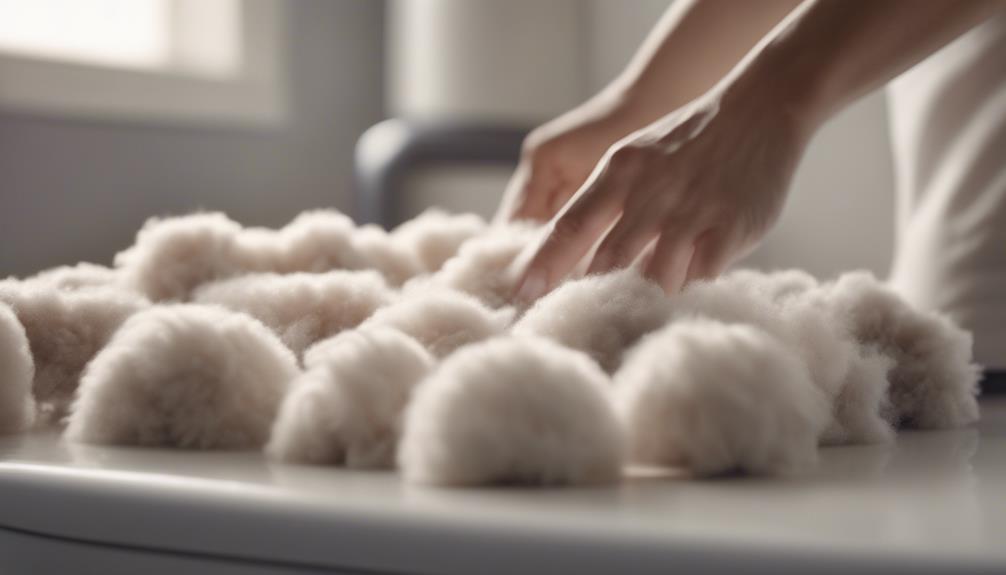
Maintaining the fluffiness of your UGG comforter requires regular shaking and fluffing to preserve its soft texture between washings. While machine washing can be convenient, it may lead to a loss of fluffiness over time due to the agitation of the machine.
The agitators in washing machines can cause the comforter's fibers to clump together, resulting in a less fluffy appearance. To minimize this impact, consider using a gentle cycle and mild detergent when washing your UGG comforter. After washing, air drying the comforter can help preserve its fluffiness by allowing the fibers to naturally regain their loft.
Additionally, regularly shaking out the comforter and fluffing it up can also aid in maintaining its fluffy texture between washings. By following these tips and being mindful of the washing process, you can help guarantee that your UGG comforter stays soft, fluffy, and cozy for a long time.
Stain Removal Techniques for UGG Comforter

Regularly addressing stains on your UGG comforter is vital to maintain its pristine appearance and longevity. When dealing with stains, it's important to act promptly using gentle detergent and a damp cloth or sponge to dab at the affected area. Avoid aggressive rubbing or scrubbing, as this can damage the fabric.
Before using any stain removal solution, test it on a small, inconspicuous area to make sure it doesn't impact the color of the comforter. For tough stains, consider using an enzyme-based cleaner specifically designed for fabrics.
After treating the stain, remember to blot the area with a clean, dry cloth to soak up excess moisture and prevent it from spreading. By following these cleaning tips and using the appropriate stain removal techniques, you can effectively maintain the quality and appearance of your UGG comforter for years to come.
Long-Term Care for UGG Comforter
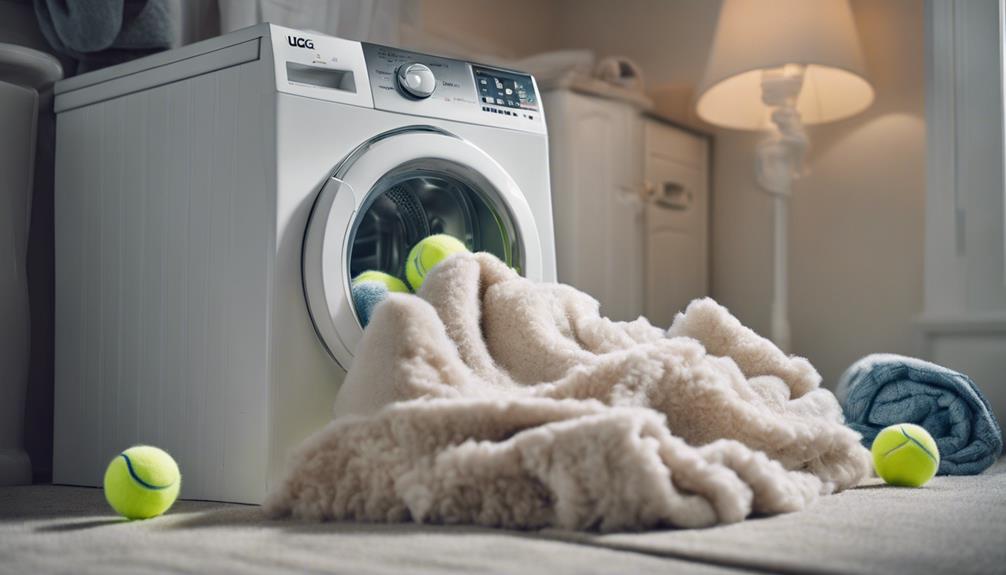
When it comes to guaranteeing the longevity of your UGG comforter, proper long-term care is key, including following specific washing guidelines for machine washing. Using a front-loading washing machine on a gentle cycle is the best way to clean your UGG comforter without causing damage.
Always remember to check the care label on the comforter for any specific washing instructions provided by the manufacturer. It's recommended to wash the comforter every 3-6 months to maintain its cleanliness and extend its lifespan. However, if you're sensitive to allergens or live in dusty environments, you may need to launder the comforter more frequently.
Frequently Asked Questions
Can I Put My UGG Blanket in the Washer?
Yes, we can put our UGG blanket in the washer. It's safe to machine wash it in a front-loading machine on a gentle cycle. Use a mild detergent and avoid harsh chemicals to protect the blanket.
Washing it with similar items can help maintain its quality and prevent uneven wear. Always check the care label for specific instructions. Avoid washing large UGG blankets in machines with agitators to prevent fiber damage.
What Happens to Uggs in the Washing Machine?
When we wash Uggs in the machine, the delicate fibers can get damaged, affecting their fluffiness.
Agitation might cause the fabric to wear down, losing softness over time.
Spinning too much can lead to uneven filling distribution, making the Uggs lumpy.
It's best to follow manufacturer's care instructions to avoid potential issues and maintain the product's quality.
How Do You Get Stains Out of White UGG Comforters?
To effectively remove stains from white UGG comforters, gently treat them immediately with cold water and a mild detergent. Avoid harsh scrubbing to prevent damage. Test a small hidden spot first to confirm the cleaning solution won't affect the color.
Air dry the comforter after spot cleaning to preserve its quality and brightness. Following these steps will help maintain the pristine look of your white UGG comforter.
Can I Put My Uggs in the Dryer?
No, it isn't recommended to put Uggs in the dryer. The heat can damage the sheepskin material, causing shrinkage and stiffness.
For best results, air drying is the way to go. Avoid direct heat sources like radiators and sunlight to prevent harm.
Let your Uggs air dry at room temperature to maintain softness and shape. This method preserves quality and longevity, ensuring comfort when wearing them.
Is Dry Cleaning or Machine Washing More Suitable for Cleaning My Ugg Comforter?
When it comes to cleaning your Ugg comforter, it is best to opt for dry cleaning. Machine washing can damage the delicate fabric and construction of the comforter, leading to shrinkage and loss of softness. To maintain the quality and longevity of your Ugg comforter, it’s recommended to dry clean Ugg comforter.
Conclusion
To sum up, machine washing your UGG comforter is a straightforward process that can help maintain its quality and comfort.
Just like a gentle spin cycle, proper care and attention will guarantee your comforter stays fluffy and cozy for years to come.
Remember to follow the care instructions, use the right detergent, and avoid common washing mistakes to keep your UGG comforter looking and feeling its best.
Happy washing!
